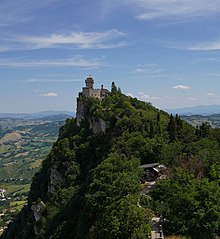


The Three Towers of San Marino are a group of towers located in San Marino. Located on the three peaks of Monte Titano in the capital, also called San Marino, they are depicted on both the national flag and coat of arms.



The Three Towers of San Marino are a group of towers located in San Marino. Located on the three peaks of Monte Titano in the capital, also called San Marino, they are depicted on both the national flag and coat of arms.
The Guaita is the oldest of the three towers, and the most famous. It was constructed in the 11th century and served briefly as a prison. [1] It was rebuilt numerous times and reached its current form in the 15th century during the war fought between San Marino and the House of Malatesta.[ citation needed ]
The Cesta is located on the highest of Monte Titano's summits. A museum to honour Saint Marinus, created in 1956, is located in this tower and showcases over 1,550 weapons dating from the Medieval Era to the modern day. [1] It was constructed in the 13th century on the remains of an older Roman fort.
The Montale is located on the smallest of Monte Titano's summits. Unlike the other towers, this one is not open to the public. It was constructed in the 14th century. [1] It is thought to have been constructed to give protection against the increasing power of the Malatesta family in that region.[ citation needed ] It was also used as a prison, and accordingly, the only entrance to the tower is a door about seven metres from ground level, which was common for prison architecture of the time. [2]